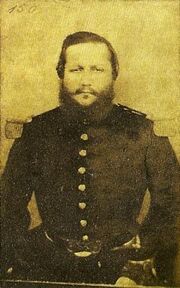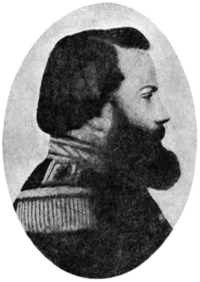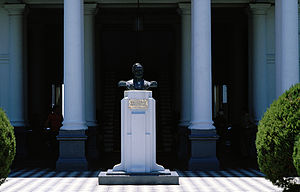| Francisco Solano López | |
|---|---|

| |
| Last picture of Francisco Solano López, c. 1870 | |
| 2nd President of Paraguay | |
In office 10 September 1862 – 1 March 1870 | |
| Vice President | Domingo Francisco Sánchez |
| Preceded by | Carlos Antonio López |
| Succeeded by | Cirilo Antonio Rivarola |
| Personal details | |
| Born | July 24, 1827 Asunción, Paraguay |
| Died | March 1, 1870 (aged 42) Cerro Corá, Paraguay |
| Political party | None |
| Spouse(s) | Eliza Lynch |
| Children | Juan Francisco Corina Adelaida Enrique Venancio Federico Morgan Lloyd Carlos Honorio Leopoldo |
| Religion | Roman Catholic |
| Signature | 
|
Francisco Solano López Carrillo (24 July 1827 – 1 March 1870) was president of Paraguay from 1862 until his death in 1870. He was the eldest son of president Carlos Antonio López, whom had left his son a prosperous nation.
Solano López is widely regarded as being responsible for the disastrous War of the Triple Alliance, which led to his death.
Life and career[]
Life before the war[]

Solano López around age 28, c.1854
Solano López was born in Manorá, a barrio of Asunción. He was made Brigadier General of the Paraguayan Army by his father at the age of 18, in 1844, during the spasmodic hostilities then prevailing with Argentina.[1] He was sent in 1853 as minister plenipotentiary to the United Kingdom, France, and Italy, and spent a year and a half in Europe. He purchased large quantities of arms and military supplies, together with several steamers, and organized a project for building a railroad and establishing a French colony in Paraguay. He also became infatuated with the empire of Napoleon III and with Napoleon Bonaparte himself.[2] López equipped his army with exact copies of uniforms of Napoleonic army. He ordered for himself an exact replica of Napoleon's crown.[3] While there, he met a Parisian courtesan, the Irishwoman Eliza Lynch, and brought her with him back to Paraguay. There she was his mistress and de facto first lady till his death, strongly influencing his later ambitious schemes.
Returning to Paraguay, Solano López became Minister of War in 1855. He was appointed as Vice President by his father.[4][5]
In November 1859, López was on board the war steamer Tacuari, which was attacked by British Royal Navy ships attempting to pressure his father into releasing a British citizen from prison. The British consul who ordered the attack was Sir William Thornton, who would later personally support Argentina in the War of the Triple Alliance.[6]
When his father died in 1862, López called a congress that unanimously chose him as president for ten years.[2]
Role in beginning the war[]

López at age 33, 1859
In 1864, Brazil – which did not have friendly relations with Paraguay – began supporting a rising revolution in Uruguay by Venancio Flores against the White party government of Atanasio Aguirre, who was an ally of Paraguay.[7] Uruguay requested Paraguay to intervene in the matter. López manifested this support via a letter to Brazil, in which he said that any occupation of Uruguayan lands by Brazil would be considered as an attack on Paraguay.[8] When Brazil did not heed the letter and invaded Uruguay on 12 October 1864, López seized the Brazilian merchant steamer Marqués de Olinda in the harbor of Asunción[9] and imprisoned the Brazilian governor of the province of Mato Grosso, who was on board. In the following month (December 1864) he dispatched a force to invade Mato Grosso. The force seized and sacked the town of Corumbá and took possession of the province and its diamond mines, together with an immense quantity of arms and ammunition, including enough gunpowder to last the whole Paraguayan Army for at least a year of active war.[10] However, Paraguayan forces could not or would not seize the capital city of Cuiabá, in northern Mato Grosso.
López next intended to send troops to Uruguay to support the government of his ally, yet when he requested permission from Argentina to cross Argentine soil, Argentine President Bartolomé Mitre refused to allow the Paraguayan force to cross the intervening Argentine province of Corrientes.[9] By then Brazil had already overthrown the Uruguayan government of Aguirre and installed Flores in his stead, rendering Uruguay little more than a Brazilian puppet state.[1] A hastily summoned congress composed of López's own nominees bestowed the title of "marshal" upon him and gave him extraordinary war powers. On 13 April 1865, he declared war on Argentina, seizing two Argentine war vessels in the Bay of Corrientes. The next day, he occupied the town of Corrientes, instituted a provisional government of his Argentine partisans, and announced that Paraguay had annexed Corrientes Province and Argentina's Entre Ríos Province. On 1 May 1865, Brazil joined Argentina and Uruguay in signing the Treaty of the Triple Alliance, which stipulated that they should unitedly pursue war with Paraguay until the existing government of Paraguay was overthrown and "until no arms or elements of war should be left to it." This agreement was literally carried out.
War of the Triple Alliance[]

Francisco Solano López, c.1864
The war which ensued, lasting until 1 March 1870, was carried on with great stubbornness and with alternating fortunes, though López's disasters steadily increased. On 12 September 1866, López invited Mitre to a conference in Yatayty Corá. López believed that the time was right to treat for peace[11] and was ready to sign a peace treaty with the Allies.[12] No agreement was reached though since Mitre's conditions for rendition were that every article of the Secret Treaty of the Triple Alliance was still to be carried out, a condition to which López refused.[9] Regardless of López's refusal, a peace treaty was not something Mitre could guarantee since article 6 in the secret treaty stated that "The allies solemnly commit themselves not to abandon arms unless commonly agreed, and as long as they haven’t overthrown the current government of Paraguay, as well as not to try separately, nor sign any peace treaty, truce, armistice which would put an end to or suspend the war, unless agreed by all parties".[13] This not only rendered any possibility of truce or peace nearly impossible but also stipulated that the war was to continue until the current government ceased to be, which meant the death of López.
In 1868, when the allies were pressing him hard, he convinced himself that his Paraguayan supporters had actually formed a conspiracy against his life. Thereupon, several hundred prominent Paraguayan citizens were seized and executed by his order, including his brothers and brothers-in-law, cabinet ministers, judges, prefects, military officers, bishops and priests, and nine-tenths of the civil officers, together with more than two hundred foreigners, among them several members of the diplomatic legations (the San Fernando massacres). During this time he also had his 70-year-old mother flogged and ordered her execution, because she revealed to him that he had been born out of wedlock.[14]
Battle of Cerro Corá[]

Profile view of López, 1870
López was at last driven with a handful of troops to the northern frontier of Paraguay. He arrived at Cerro Corá on 14 February 1870. Two detachments were sent in pursuit of Solano López, who was accompanied by 200 men in the forests in the north, where he received news of the considerable Brazilian forces that were closing in on him. This caused some of the officials who were still with López to abandon him and approach the allied force, under the command of the Brazilian General José Antônio Correia da Câmara, which they readily joined as scouts in order to lead them to López.[15]
Upon hearing about this, López called a last war council with the remaining officers of his general staff in order to decide the course of action for the upcoming battle: whether they should escape into the hill range or stay and make a stand against the attackers. The counsel decided to stay and end the war once and for all by fighting to the death.[16]
The Brazilian force reached the camp on the 1 March. During the battle that ensued, López was separated from the remainder of his army and was accompanied only by his aide and a couple of officers. He had been wounded with a spear in the stomach and hit with a sword in the side of his head and so was too weak to walk by himself.[17] They led him to the Aquidabangui stream, and there they left him on the pretext of getting reinforcements. While Lopez was alone with his aide, General Câmara arrived along with six soldiers and approached him, calling on him to surrender and guaranteeing his life. López refused and shouting Muero con mi patria! (I die with my nation),[18] tried to attack Câmara with his sword. Câmara ordered him to be disarmed, but López died during the struggle with the soldiers who were trying to disarm him.[19] This incident marked the end of the war of the Triple Alliance.
Legacy[]

A bust of Solano López in Asunción
There is a debate within Paraguay as to whether he was a fearless leader who led his troops to the end, or whether he foolishly led Paraguay into a war which it could never possibly win, and which nearly eliminated the country from the map. This debate was not helped by the revisionist stance taken by the Stroessner regime, regarding national history. Conversely, he is considered by some Latin Americans as a champion for the rights of smaller nations against the imperialism of more powerful neighbors. For example, Eduardo Galeano argues that he and his father continued the work of José Gaspar Rodríguez de Francia in defending Paraguay as "the only country that foreign capital had not deformed".[20]
There is an ongoing debate in Paraguay among historians regarding López's final words. The two versions are Muero por mi patria ("I die for my nation") or 'Muero con mi patria ("I die with my nation").[21] Regarding the event, Juan Silvano Godoi wrote:
Marshal López died profoundly convinced that, along with him, the independence of Paraguay would disappear. He acquired this conviction upon learning that the allies had organized in Asuncion a "temporary government" made up of the Paraguayans who had taken arms against their government and fought for the Triple Alliance army.[21]
1 March is a national holiday in Paraguay, called "Dia de los Heroes" (Heroes' Day), held in honor of López's memory. It is the most important holiday in the country next to the independence day. To date, López is considered to be the greatest Paraguayan national hero and his remains are located at the "Panteon de los Heroes" (National Pantheon of the Heroes) in Asunción. It is customary in Asunción that when something historic worth celebrating happens (such as the victory of the former President Lugo in the 2008 elections) people flock with their flags to the street in front of it and celebrate the event.
Recently, Argentine president Cristina Kirchner named an Argentinean military unit after Marshal Francisco Solano López. It was the 2nd Armored Artillery Group.[22] During the ceremony the national anthem of both nations was sung and high-ranking officers of both armies were present. The Chief of the Argentine Army gave a speech at the event in which he stated: "Talking about the Paraguayan Army and the Argentine Army is talking of one and the same thing. Today, in the Argentine army, honored by the visit of Paraguay's Army Commandant, we are working intensely in fulfilling the dream of the fathers of our nation. Of those men who wanted to build a great nation, General San Martín and, precisely, Marshal López.".[22] Afterwards, Lieutenant General Bendini said:
Marshall López inspired in his men a spirit and love for their land which made them prefer to die rather than surrendering. He is an example of what a leader is, a driver, a man who knows how to reach to his people. I am sure that the men of this artillery group will take the example of this brave Paraguayan soldier and will be deemed worthy of the name their unit carries.[22]
At the end of the ceremony the Paraguayan Army Commandant presented the unit with a portrait of López.
The Paraguayan President's Office is called "Palacio de López" (Lopez's Palace) as it was built by López before the war as his home. However, it was never finished until after the war was over so he never resided in it.
The life of López is the basis for the play Visions by Louis Nowra.
Endnotes[]
References[]
- ↑ 1.0 1.1 Hanratty, Dannin M. and Meditz, Sandra W., editors. Paraguay: A Country Study. Washington: GPO for the Library of Congress, 1988.
- ↑ 2.0 2.1 Hanratty
- ↑ Shaw, Karl (2005) [2004] (in Czech). Power Mad! [Šílenství mocných]. Praha: Metafora. pp. 29–30. ISBN 80-7359-002-6.
- ↑ "Historical list". ABC Digital. http://www.abc.com.py/2008-04-20/articulos/407914/uno-que-se-va-otroa-que-llega.
- ↑ "Gallery". Vicepresidency of Paraguay. http://vicepresidencia.gov.py/?categoria=11&t=galeria-de-vicepresidentes.
- ↑ TRATADO DE LAS PUNTAS DEL ROSARIO (Guerra del Paraguay) (Spanish)
- ↑ Vasconsellos, Victor N. Resumen de Historia del Paraguay. Delimitaciones Territoriales’’, Industria Grafica Comuneros S.A. Asunción, Paraguay, 1970. Page 107.
- ↑ Vasconsellos. Page 107.
- ↑ 9.0 9.1 9.2 Vasconsellos. Page 108.
- ↑ Washburn,Charles A. "History of Paraguay" Lee and Shepard, Publishers. 1871. Vol II Page 9.
- ↑ Cardozo, Efrain"Breve Historia del Paraguay"El Lector. 1996. Page 87
- ↑ Vasconsellos. Page 108
- ↑ "Tratado Secreto de la Triple Alianza". http://www.congreso.gov.py/senadores/leyes/ups/leyes/5660TRATADO%20SECRETO%20DE%20LA%20TRIPLE%20ALIANZA.doc. Retrieved 27 September 2009.[dead link]
- ↑ Shaw, Karl (2005) [2004] (in Czech). Power Mad! [Šílenství mocných]. Praha: Metafora. pp. 11–12. ISBN 80-7359-002-6.
- ↑ Bareiro Saguier, Ruben; Villagra Marsal, Carlos. Testimonios de la Guerra Grande. Muerte del Mariscal López. Tomo I, Editorial Servilibro. Asuncion, Paraguay, 2007. Page 66.
- ↑ Bareiro. Page 66.
- ↑ Bareiro. Page 68, 80.
- ↑ Bareiro. Page 70, 82, 98.
- ↑ Bareiro. Page 90.
- ↑ Eduardo Galeano, Open Veins of Latin America, Monthly Review Press, New York, 1973, 1997, pp 188–189.
- ↑ 21.0 21.1 Bareiro. Page 85.
- ↑ 22.0 22.1 22.2 "Bautizan unidad militar Argentina en honor al prócer paraguayo Mariscal Francisco Solano López". http://www.soldadosdigital.com/2007/138-noviembre/nota_principal.htm. Retrieved 27 October 2009.
Bibliography[]
- Bray, Arturo (1984) (in Spanish). Solano López: soldado de la gloria y del infortunio (3 ed.). Asunción: Carlos Schauman Editor.
- Graham, Robert Bontine Cunninghame (1933). Portrait of a dictator. London: William Heinemann.
- Leuchars, Chris (2002). To the bitter end: Paraguay and the War of the Triple Alliance. Westport, Connecticut: Greenwood Press. ISBN 0-313-32365-8.
- Munro, Dana Gardner (1960). The Latin American Republics: A History (3 ed.). New York: Appleton-Century-Crofts.
- Raine, Philip (1956). Paraguay. New Brunswick, New Jersey: Scarecrow Press.
- Saeger, James Schofield (2007). Francisco Solano López and the Ruination of Paraguay: Honor and Egocentrism. Lanham, Maryland: Rowman & Littlefield Publishers. ISBN 978-0-7425-3754-5.
- Whigham, Thomas L. (2002). The Paraguayan War: Causes and early conduct. 1. Lincoln, Nebraska: University of Nebraska Press. ISBN 978-0-8032-4786-4.
External links[]
| Wikimedia Commons has media related to Francisco Solano López. |
The original article can be found at Francisco Solano López and the edit history here.